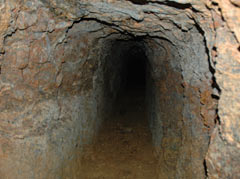One of the largest wartime shelters discovered in northern Okinawa found in Motobu

On May 25, inside the shelter found in the Kenken area of Motobu.
May 27, 2012 Ryukyu Shimpo
A dug-out shelter that would seem to have been built by the Imperial Japanese
Army (IJA) has been found in the hills of the Kenken district of Motobu. It is about 30 meters long, up to about two meters high and is one meter wide, and is probably one of the largest shelters surviving intact in the northern region of Okinawa. Tetsuo Tomori of the Motobu Municipal Museum said, “It is rare to find a shelter so large and well-preserved. We would like to consider using it for peace education.”
Local residents came across the shelter at the end of April, when work was restarted on upgrading a walking track that had been left unattended to for 21 years. There were no human remains inside the shelter, so Tomori surmised that, “The Imperial Japanese Army may have actually abandoned the location before it could be used in battle.”

According to a 10 August 1944 entry in the staff diary of the No. 3 Battalion of 15th Independent Mixed Regiment, a platoon of heavy artillery was deployed near Tobaru, which is close to Kenken, in order to provide fire-support to the forces on the island of Ie-jima. The shelter seems to be in this location. It was seen as critical for IJA units in the northern part of Okinawa to help protect Ie-jima, where important airfields were located.
Seventy-four year-old resident of Kenken Tatsuhiko Shiroma remembers seeing dozens of Korean laborers led by armed Japanese soldiers up towards the hills on a daily basis in the summer of 1944. He said, “I imagine that it was those Koreans who built the shelter.”
According to Shiroma, there was no fighting between the Imperial Japanese Army and the U.S. forces in the area because IJA troops retreated from Kenken after the massive air raid on Japanese installations in Okinawa on 10 October 1944. Shiroma said, “The Imperial Japanese Army suffered losses during that air raid, and may have changed their strategy, withdrawing from that location.”
(English translation by T&CT, Mark Ealey)
Previous Article:Yonner Food offers cooking experience course as a new tourism plan
Next Article:Okinawa Kizuna Declaration
[Similar Articles]
- Town needs to work to preserve Tanabaru Field Hospital Shelter
- Volunteers excavate remains
- A large quantity of ordnance found in Itoman
- OPG to set up an explanation board about the former 32nd Army Headquarters Shelter at Shuri
- Participants from Japan, South Korea, and Taiwan search for remains of Battle of Okinawa victims in Kenken, Motobu, wish for peace in East Asia
 Webcam(Kokusai Street)
Webcam(Kokusai Street)


